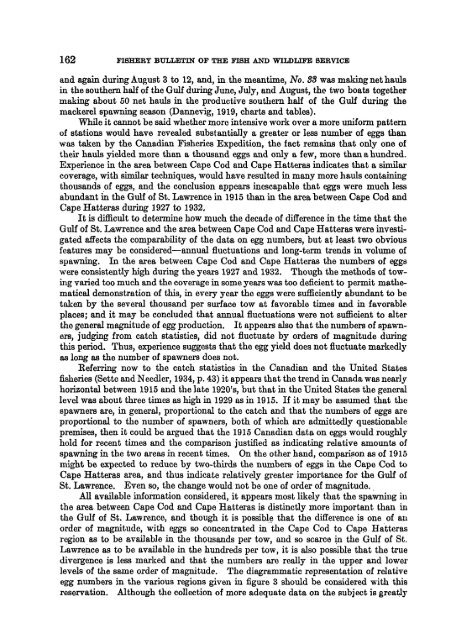Fishery bulletin of the Fish and Wildlife Service - NOAA
Fishery bulletin of the Fish and Wildlife Service - NOAA
Fishery bulletin of the Fish and Wildlife Service - NOAA
You also want an ePaper? Increase the reach of your titles
YUMPU automatically turns print PDFs into web optimized ePapers that Google loves.
162 FISHERY BULLETIN OP THE FISH AND WILDLIFE 8EBVICE<br />
<strong>and</strong> again during August 3 to 12, <strong>and</strong>, in <strong>the</strong> meantime, No. SS was making net hauls<br />
in <strong>the</strong> sou<strong>the</strong>rn half <strong>of</strong> <strong>the</strong> Gulf during June, July, <strong>and</strong> August, <strong>the</strong> two boats toge<strong>the</strong>r<br />
making about 50 net hauls in <strong>the</strong> productive sou<strong>the</strong>rn half <strong>of</strong> <strong>the</strong> Gulf during <strong>the</strong><br />
mackerel spawning season (Dannevig, 1919, charts <strong>and</strong> tables).<br />
While it cannot be said whe<strong>the</strong>r more intensive work over a more uniform pattern<br />
<strong>of</strong> stations would have revealed substantially a greater or less number <strong>of</strong> eggs than<br />
was taken by <strong>the</strong> Canadian <strong>Fish</strong>eries Expedition, <strong>the</strong> fact remains that only one <strong>of</strong><br />
<strong>the</strong>ir hauls yielded more than a thous<strong>and</strong> eggs <strong>and</strong> only a few, more than a hundred.<br />
Experience in <strong>the</strong> area between Cape Cod <strong>and</strong> Cape Hatteras indicates that a similar<br />
coverage, with similar techniques, would have resulted in many more hauls containing<br />
thous<strong>and</strong>s <strong>of</strong> eggs, <strong>and</strong> <strong>the</strong> conclusion appears inescapable that eggs were much less<br />
abundant in <strong>the</strong> Gulf <strong>of</strong> St. Lawrence hi 1915 than in <strong>the</strong> area between Cape Cod <strong>and</strong><br />
Cape Hatteras during 1927 to 1932.<br />
It is difficult to determine how much <strong>the</strong> decade <strong>of</strong> difference in <strong>the</strong> tune that <strong>the</strong><br />
Gulf <strong>of</strong> St. Lawrence <strong>and</strong> <strong>the</strong> area between Cape Cod <strong>and</strong> Cape Hatteras were investigated<br />
affects <strong>the</strong> comparability <strong>of</strong> <strong>the</strong> data on egg numbers, but at least two obvious<br />
features may be considered—annual fluctuations <strong>and</strong> long-term trends in volume <strong>of</strong><br />
spawning. In <strong>the</strong> area between Cape Cod <strong>and</strong> Cape Hatteras <strong>the</strong> numbers <strong>of</strong> eggs<br />
were consistently high during <strong>the</strong> years 1927 <strong>and</strong> 1932. Though <strong>the</strong> methods <strong>of</strong> towing<br />
varied too much <strong>and</strong> <strong>the</strong> coverage in some years was too deficient to permit ma<strong>the</strong>matical<br />
demonstration <strong>of</strong> this, in every year <strong>the</strong> eggs were sufficiently abundant to be<br />
taken by <strong>the</strong> several thous<strong>and</strong> per surface tow at favorable tunes <strong>and</strong> in favorable<br />
places; <strong>and</strong> it may be concluded that annual fluctuations were not sufficient to alter<br />
<strong>the</strong> general magnitude <strong>of</strong> egg production. It appears also that <strong>the</strong> numbers <strong>of</strong> spawners,<br />
judging from catch statistics, did not fluctuate by orders <strong>of</strong> magnitude during<br />
this period. Thus, experience suggests that <strong>the</strong> egg yield does not fluctuate markedly<br />
as long as <strong>the</strong> number <strong>of</strong> spawners does not.<br />
Referring now to <strong>the</strong> catch statistics in <strong>the</strong> Canadian <strong>and</strong> <strong>the</strong> United States<br />
fisheries (Sette <strong>and</strong> Needier, 1934, p. 43) it appears that <strong>the</strong> trend in Canada was nearly<br />
horizontal between 1915 <strong>and</strong> <strong>the</strong> late 1920's, but that hi <strong>the</strong> United States <strong>the</strong> general<br />
level was about three times as high in 1929 as in 1915. If it may be assumed that <strong>the</strong><br />
spawners are, in general, proportional to <strong>the</strong> catch <strong>and</strong> that <strong>the</strong> numbers <strong>of</strong> eggs are<br />
proportional to <strong>the</strong> number <strong>of</strong> spawners, both <strong>of</strong> which are admittedly questionable<br />
premises, <strong>the</strong>n it could be argued that <strong>the</strong> 1915 Canadian data on eggs would roughly<br />
hold for recent tunes <strong>and</strong> <strong>the</strong> comparison justified as indicating relative amounts <strong>of</strong><br />
spawning in <strong>the</strong> two areas in recent tunes. On <strong>the</strong> o<strong>the</strong>r h<strong>and</strong>, comparison as <strong>of</strong> 1915<br />
might be expected to reduce by two-thirds <strong>the</strong> numbers <strong>of</strong> eggs in <strong>the</strong> Cape Cod to<br />
Cape Hatteras area, <strong>and</strong> thus indicate relatively greater importance for <strong>the</strong> Gulf <strong>of</strong><br />
St. Lawrence. Even so, <strong>the</strong> change would not be one <strong>of</strong> order <strong>of</strong> magnitude.<br />
All available information considered, it appears most likely that <strong>the</strong> spawning in<br />
<strong>the</strong> area between Cape Cod <strong>and</strong> Cape Hatteras is distinctly more important than in<br />
<strong>the</strong> Gulf <strong>of</strong> St. Lawrence, <strong>and</strong> though it is possible that <strong>the</strong> difference is one <strong>of</strong> an<br />
order <strong>of</strong> magnitude, with eggs so concentrated hi <strong>the</strong> Cape Cod to Cape Hatteras<br />
region as to be available in <strong>the</strong> thous<strong>and</strong>s per tow, <strong>and</strong> so scarce in <strong>the</strong> Gulf <strong>of</strong> St.<br />
Lawrence as to be available in <strong>the</strong> hundreds per tow, it is also possible that <strong>the</strong> true<br />
divergence is less marked <strong>and</strong> that <strong>the</strong> numbers are really in <strong>the</strong> upper <strong>and</strong> lower<br />
levels <strong>of</strong> <strong>the</strong> same order <strong>of</strong> magnitude. The diagrammatic representation <strong>of</strong> relative<br />
egg numbers in <strong>the</strong> various regions given in figure 3 should be considered with this<br />
reservation. Although <strong>the</strong> collection <strong>of</strong> more adequate data on <strong>the</strong> subject is greatly

















